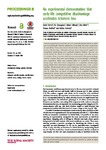An experimental demonstration that early-life competitive disadvantage accelerates telomere loss
| dc.contributor.author | Nettle, D | |
| dc.contributor.author | Monaghan, P | |
| dc.contributor.author | Gillespie, R | |
| dc.contributor.author | Brilot, B | |
| dc.contributor.author | Bedford, T | |
| dc.contributor.author | Bateson, M | |
| dc.date.accessioned | 2015-10-21T16:29:00Z | |
| dc.date.available | 2015-10-21T16:29:00Z | |
| dc.date.issued | 2015-01-07 | |
| dc.identifier.issn | 0962-8452 | |
| dc.identifier.issn | 1471-2954 | |
| dc.identifier.other | 20141610 | |
| dc.identifier.uri | http://hdl.handle.net/10026.1/3693 | |
| dc.description.abstract |
<jats:p> Adverse experiences in early life can exert powerful delayed effects on adult survival and health. Telomere attrition is a potentially important mechanism in such effects. One source of early-life adversity is the stress caused by competitive disadvantage. Although previous avian experiments suggest that competitive disadvantage may accelerate telomere attrition, they do not clearly isolate the effects of competitive disadvantage from other sources of variation. Here, we present data from an experiment in European starlings ( <jats:italic>Sturnus vulgaris</jats:italic> ) that used cross-fostering to expose siblings to divergent early experience. Birds were assigned either to competitive advantage (being larger than their brood competitors) or competitive disadvantage (being smaller than their brood competitors) between days 3 and 12 post-hatching. Disadvantage did not affect weight gain, but it increased telomere attrition, leading to shorter telomere length in disadvantaged birds by day 12. There were no effects of disadvantage on oxidative damage as measured by plasma lipid peroxidation. We thus found strong evidence that early-life competitive disadvantage can accelerate telomere loss. This could lead to faster age-related deterioration and poorer health in later life. </jats:p> | |
| dc.format.extent | 0-0 | |
| dc.format.medium | ||
| dc.language | en | |
| dc.language.iso | en | |
| dc.publisher | The Royal Society | |
| dc.subject | telomeres | |
| dc.subject | early-life adversity | |
| dc.subject | early-life stress | |
| dc.subject | oxidative stress | |
| dc.subject | starlings | |
| dc.subject | Sturnus vulgaris | |
| dc.title | An experimental demonstration that early-life competitive disadvantage accelerates telomere loss | |
| dc.type | journal-article | |
| dc.type | Article | |
| plymouth.author-url | https://www.ncbi.nlm.nih.gov/pubmed/25411450 | |
| plymouth.issue | 1798 | |
| plymouth.volume | 282 | |
| plymouth.publication-status | Published | |
| plymouth.journal | Proceedings of the Royal Society B: Biological Sciences | |
| dc.identifier.doi | 10.1098/rspb.2014.1610 | |
| plymouth.organisational-group | /Plymouth | |
| plymouth.organisational-group | /Plymouth/Faculty of Science and Engineering | |
| plymouth.organisational-group | /Plymouth/REF 2021 Researchers by UoA | |
| plymouth.organisational-group | /Plymouth/REF 2021 Researchers by UoA/UoA04 Psychology, Psychiatry and Neuroscience | |
| dc.publisher.place | England | |
| dcterms.dateAccepted | 2014-10-21 | |
| dc.identifier.eissn | 1471-2954 | |
| dc.rights.embargoperiod | Not known | |
| rioxxterms.versionofrecord | 10.1098/rspb.2014.1610 | |
| rioxxterms.licenseref.uri | http://www.rioxx.net/licenses/all-rights-reserved | |
| rioxxterms.licenseref.startdate | 2015-01-07 | |
| rioxxterms.type | Journal Article/Review |


